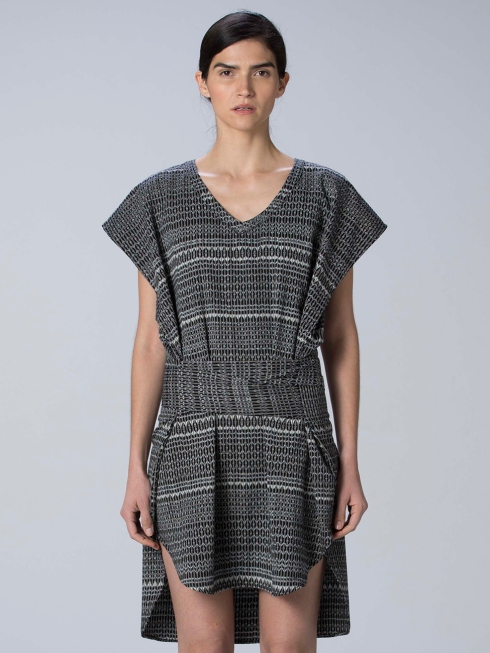Carla Fernandez is a Mexican fashion designer, renowned for pioneering the creation of her very own fashion label, Taller Flora. Despite her inherent passion in the industry, Fernandez says the professional fashion industry involves many struggles. Carla is Mexican born, and her designs are thus inspired by her heritage by combining elements that connote the Mexican culture. Her designs are sold in Mexico, USA, London and Japan. (Design Indaba 2017)
Fernandez had a pleasant upbringing in Northern Mexico. Her parents are both native to the areas, and her father was the director of archaeological sites in said area. She reminisces that she would often cross the northern border of Mexico into the United States in order to go shopping. This, she says, is how she cultivated her own inspiration and sense of style for the fashion industry she works within today, that style being an infusion of both indigenous Mexican and American fashion.
In her way of thinking, Carla merges old with new, simplicity with complex and tradition with forward-thinking in her designs. Due to the demands of his career, Fernandez and her mother would often travel in pursuit of their father. As a result, she was afforded the opportunity to visit different indigenous communities, learn their traditions, visit their homes. During these visits, Fernandez was inspired by the way the local communities would design and create their garments. (Fuentes 2009)
She created a portable fashion lab, which she uses to travels around Mexico. She travels to different indigenous communities with companies that handcraft textiles and sets up workshops there to learn and teach fashion design. She works with women in the indigenous communities to enrich herself with their culture and heritage. By doing so, the indigenous communities teach her the different ways that the garments can be made that speaks to their country’s heritage therefore helping Carla in creating her own garments for her clothing line. (Design Indaba 2017). By visiting these communities and studying traditional Mexican garment making techniques, Carla saw that everything was made out of squares and rectangles. It was a very specific identity that they used to make a fashion statement in Mexico. That 90% of the clothing comes from these squares and rectangles shapes. (Design Indaba 2014)
Her designs involve techniques used from the indigenous communities’ heritage and culture, geometric shapes such as squares and rectangles, bold colours, and clothing that tells a story in the garments. Her mission by traveling to different indigenous communities is not simply limited to learning about their heritage or culture or creating fashionable clothing, but to also protect the environment and to enrich the people’s lives as well as improving the sense of culture within these rural communities. (Fuentes 2009)
Within the fashion industry, it is no mystery that fast-fashion is the most efficient. Therefore, Fernandez’ biggest obstacle, currently, is that her garments are ethically produced by work of hand, which is known to cost much in time and resources. She does this by a series of techniques. Dresses and fringes are made using the hammock techniques. Molinillos are used to make chocolate, however now they are used to make accessories such as sunglasses, bracelets, shoes, etc. Rebozos is a method used to make a specific garment. It takes 13 different people to make a Rebozos due to its difficulty and it takes them a month and a half to make one. They always get the communities involve in a certain way. This method has been used for 3 thousand years.

Despite the inefficiencies of handwork, Fernandez maintains the uniqueness of her designs as the motivations, claiming she was surprised that fashion designers in Mexico didn’t look and use their heritage as an inspiration for their work, instead opting for mainstream international trends to guide their designs. The endless style, design, materials and shapes gave her the inspiration to use for her work. (Fuentes 2009).
As Carla thinks and looks towards the future, she already knows and says that the next generation would continue on with the Mexican techniques due to having the skills being passed down from generation to generation regarding their heritage designs. (Design Indaba 2014)
By Ammy Luy
Carla Fernandez 2017, Pinterest, viewed 23 January 2017, <https://au.pinterest.com/p8fm/carla-fernandez/>.
Design Indaba 2014, Carla Fernandez: Working with heritage to make a fashion statement, videorecording, Vimeo, viewed 21 January 2017, <https://vimeo.com/68856955>.
Design Indaba 2017, Carla Fernandez: how heritage translate into fashion, viewed 21 January 2017, <http://www.designindaba.com/videos/conference-talks/carla-fernandez-how-heritage-translates-fashion>.
Fernandez, C. 2017, Black Rebozo Dress, viewed 23 January 2017, <http://carlafernandez.com/en/shop/black-rebozo-dress/>.
Fuentes, M. 2009, Taller Flora: Future Folk, viewed 21 January 2017, <http://www.ecofashionworld.com/Designer-Profile/TALLER-FLORA-FUTURE-FOLK.html>.
